|
Hinduism
Naguleswaram Annual festival :
Temple of spirituality
Chelvatamby Maniccavasagar
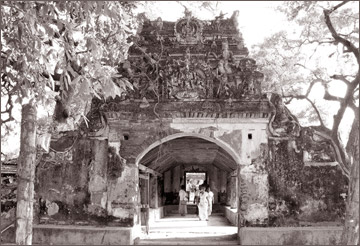 |
|
Path
through the ruins |
 |
|
Temple’s high priest, Naguleswaram
Kurrukkal |
The annual festival of Naguleswaram temple at Keerimalai, Jaffna,
commences with the flag hoisting ceremony on February 17, 2011. Further,
this temple near Kankesanturai has been declared by the eminent scholar
and historian Dr E Pieris as being one of the five recognized ‘Iswaram’
of Lord Shiva, that were in Lanka long before the arrival of Vijaya (543
BC) and which claimed and received adoration even from India. However
this temple, became to be known as Naguleswaram is attributed to it
having been the residence of a Munivar ‘Nagulamuni’ whose abode had been
a local cave inside which he lived. It is said that he got so shrunk by
age and austerities, that he was likened to be a mongoose – nakula in
Sanskrit and keeri in Tamil. Hence the name ‘Nakuleswaram’ for the
temple and ‘Keerimalai’ for the rock with the cave in it.
In fact, a local myth states that a Pandian princess named
Maruthapura Veeravalli built the nearby Maviddapuram Murukan temple
after she was cured by the Keerimalai springs.
The entire temple complex seems to have been built around the cave
and the curative springs indicate the pre-historic origin of the shrine.
The antiquity in this temple is evidenced by the writings in many
Indian religious treatises such as Dakshina Kailasa Puranam and Skanda
Puranam and also it states that the temple was a pilgrimage centre for
the South Indian Hindus.
Some traditions relating to the origins of Nakuleswaram were recorded
in the Yal Panam Vaipavamalai. During the 18th century when Yal Panam
Vaipavamalai was written, there was no temple at Keerimalai. The old
temple at the site had been destroyed by the Portuguese, but memories of
that temple had persisted in the minds of the people and the site where
it had stood was venerated as a sacred one.
Though this temple was destroyed in 1621, the local Brahmin priests
are said to have hidden the main idols before fleeing the temple.
After a gap of 400 years in 1894 local Hindus under the guidance of
Srilasiri Arumuga Navalar built the present temple.
At Naguleswaram, the daily rituals and festivals are conducted
according to the prescriptions of Agamav.
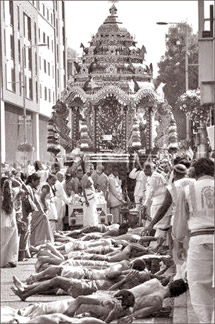 |
|
Chariot
festival at Naguleswaram |
The activities at the temple commence during the early hours of the
morning with Thirupallie Elicai and worship accompanied with rituals,
are conducted six times daily.
The annual chariot at the temple is held at the beginning of the
first week of February with the flag hoisting ceremony. A large number
of pilgrims congregate at the temple premises during the festival
season.
Indeed, the Hindu temples are intended to educate men in the art of
removing the veil of attachment that covers heads. Thus, the renowned
poet ‘Thiyagarajah’ cried in the temple at Thirupathi, remove the veil
O! Remove the veil of attachment, the veil of pride and hatred.
The chariot festival at the Naguleswaram temple is celebrated in an
elaborate manner where devotees belonging to different castes and
religions participate in large numbers. The chariot symbolizes human
body and the statue of Lord Shiva is the Soul. In front of the Chariot
are the wooden horses depicted as galloping and the reins attached to
their mouths are held in the hands of the image of Lord Shiva.
These horses represent human passions and the reins symbolize the
necessity of restraining and guiding these passions. The journey of the
Chariot through the streets symbolizes the progress of life. This shows
that throughout his life, a man must control and guide his passions.
These passions are the motive powers, the driving force of life, but
if unguided they will wreck a man’s life. This is the symbolic meaning
of the chariot festival.
Arulmigu Sri Muthumari Amman Kovil:
Ethnic and religious harmony
Richard Basnayake
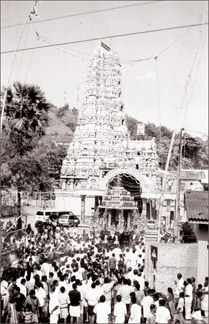 |
|
New “Raja Koburam 108 feet tall, one
of the tallest of its kind in Sri Lanka |
 |
|
Goddess
Pattini |
The historic city of Matale is blessed with many religious places.
Arulmigu Sri Muthumari Amman, Hindu Kovil is situated in the far North
end of this city. It is a very sacred Hindu shrine in Sri Lanka. This
kovil was built about 200 years ago by the Hindu community, specially
the South Indian traders, who came to Sri Lanka to do business in the
town as well as in tea estates around Matale.
There is a wonderful story about this holy shrine. A cute little
child was seen on this premises, one morning and on the following
morning a beautiful dress worn by this child was found in this place.
That very same night Goddess Pattini had appeared in a dream of a holy
man, who lived close by named Nallamuttu, and Goddess Pattini had told
this man that the cute little child who was seen at this premises was
Goddess Pattini and requested Nalla Muththu to make this place religious
shrine for Hindus to venerate. Since then this place had become a sacred
Hindu Kovil not only to Hindus but also to Buddhists.
Every year in February or March this colourful “Ther” festival is
held to evoke the blessings of Gods and specially Goddess Pattini. This
year the festival started with the “Kap” planting ceremony on January
26th and the ceremony will go on till February 20.
Everyday early morning “poojas” start at dawn with the hoisting of
flag and the “poojas” will continue till about noon. The evening
“poojas” start at six and go on till midnight. Thousands of Hindus and
Buddhists flock to this Holy shrine to offer “poojas”. Specially mothers
bring their new-born babies to get the blessings of Goddess Pattini.
This year the “Ther” - the chariot ceremony will be held on February
18, the day after Navam Full Moon Poya Day. The statues of Gods Shri
Ganeshan, Lord Murugan Sivan Ambal, Shandeshulary and Goddess Pattini
are kept in five colourfully illuminated chariots decorated with banana
trees, coconuts “thembili” and various kinds of fruits. These statues
are drawn along the streets of Matale town in the day time, by devotees
both Hindus and Buddhists. It is believed that Goddess Pattini visits
the feeble and the sick who cannot attend the “poojas” in the kovil at
their door-steps.
Long before the chariots were made the statues of Gods and Goddess
Pattini were carried on the shoulders of the devotees around the Kovil
premises. Later the Hindu community with the help of Buddhists, Muslims
and Christians collected funds to build only one chariot to take Goddess
Pattini around the town. Later three more chariots were made and now the
Kovil has five chariots.
During this holy month devotees from all parts of Sri Lanka as well
as from South India visit this kovil to offer “Poojas” and get the
blessings of Gods. The Hindus decorate their shops and houses with
traditional decorations. The Buddhists too, decorate and illuminate
their shops and houses in the town.
Kovil Management Board President S Chandrasekaram, said that, as
there is peace in the country a large number of devotees from North and
East will visit this kovil. He said about half a million will come on
the final day. He said that highly educated and religious dignitaries
have been entrusted to conduct the traditional Hindu rituals. This kovil
has a newly-built “Raja Koburam” 108 feet tall which has 1,008 statues
of Hindu deities and it is one of the tallest and most beautiful of its
kind in Sri Lanka.
The kovil authorities have made elaborate arrangements to provide
food and other refreshments to those who visit the temple, free of
charge. There will be an almsgiving on February 17 and the water-cutting
ceremony will be held on February 19 and Mal Onchillawa Flower-swing
will be on February 20 and the ceremony will come to a close.
The “Ther” festival of Sri Muthumari Amman Hindu Kovil in Matale
shows the unity among Buddhists, Hindus, Muslims and Christians and it
is called “the kovil of ethnic and religious harmony.”
The Concept of ‘I am that’
K S Sivakumaran
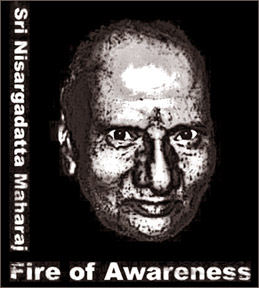 |
|
Sri
Nisargadatta Maharaj |
‘I am that” is the fundamental philosophy of Hinduism. All Hindu
sages and saints have explained that basics. One of the 20th century
religious thinkers who expounded the Hindu Philosophy was the late
Nisargadatta Maharaj, a Marati speaking Maharashtran born poor in
Mumbai. Thanks to my son, Raam Siva, I came across several books
relating to the exponent in his private library in Melbourne. One of
them is just called “I am That” published by Chetana (P) Ltd.,34, K
Dubhash Marg, Mumbai 400 023, India. First published in 1973, the book
in hand is a reprint in 2006.
Described as “a modern spiritual classic”, this book is really a
translation from the Marathi taperecordings by Maurice Frydman and
revised and edited by Sudhakar S Dikshit. The recordings include talks
with Sri Nisargadatta Maharaj.
The book carries a very clear explanatory Foreword by Prof Douwe
Tiemersma of the Erasmus University in Holland. This 536 page book
includes a note on the thinker, notes by the translator and the editor
besides very useful three Appendices, one of which is the Glossary of
terms used.
Since there is Copyright restrictions, the gems of thought cannot be
given per se in this review, except perhaps retell what is common
understanding in Hinduism which is stressed by the Maharaj. Even the
present century sage, my idol, Shri Sathya Sri Sai Baba says the same
thing while stressing the recurring theme of “LOVE”
But there may be many readers who might have not heard of Sri
Nisargadatta Maharaj. We shall therefore glean some facts about him.
We learn that this sage was a teacher “who did not propound any
ideology or religion but gently unwrapped the mystery of the ‘Self’.
He was merely a storekeeper selling ‘beedis’ in a shanty area in
Mumbai and died in 1981 at the age of 84.
We know from the ancients -from the Greek philosophers to the great
sages of the East- the perrenial questions had been: Whence am I, Who am
I, Whither am I?
In other words, this Sage also guides us to understand our true
nature and the ‘timelessness of being’.
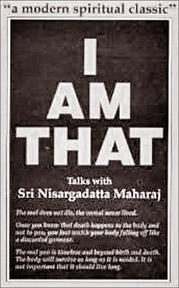 As we gather he is teaching us that our mind must recognize and
penetrate its own state of being and not ‘being this or that, here or
there, then now’, but just timeless being. As we gather he is teaching us that our mind must recognize and
penetrate its own state of being and not ‘being this or that, here or
there, then now’, but just timeless being.
The key finding by this sage who had ‘felt experience’ and guidance
from his own Guru appears to be hope for all of us: ‘beyond the real
experience is not the mind, but the self, the light in which everything
appears... the awareness in which everything happens.”
I would like to quote two revelations in relation to the Self.
The great Sankarchrya put it succinctly that “That which permeates
all, which nothing transcends and which, like the universal space around
us, fills everything completely from within and without, that Supreme
non-dual Brahman - That Thou Art
The Upanishad says; That in whom reside all beings and who resides in
all beings, who is the giver of grace to all, the Supreme Soul of the
Universe, the limitless being - I am that”
In fact as the sage has declared that at the end of a search by us of
ourselves we come to the realization that we are the limitless being.
Those of us who want to know the essence of Hinduism should also read
books like this to widen our understanding of our true nature which is
the Self “not the body, feelings, thoughts, time, space, this or that,
nothing concrete or abstract.”
mailto:[email protected]
[email protected]
 |
|
Thiruvembavai festival was celebrated
at Kovils and Hindu societies islandwide last week. Here the
special pooja “Aruthira Tharisanam” conducted by the priests
to mark the Thiruvembavai at Arulmigu Sri Ponnambala
Wanesuarar Kovil Kochchikade Colombo 13. Pictures by A
Maduraveeran |
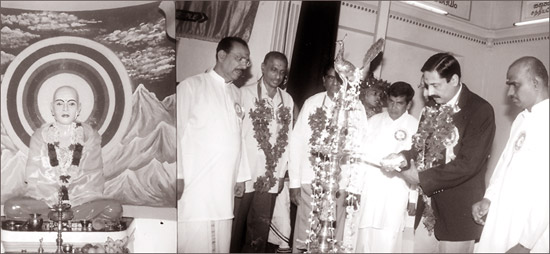 |
|
The Sri Narayana Guru Samajayam
Colombo branch conducted a special pooja and a cultural
program at the Narayana Guru Mandapam Layards Broadway
Grandpass Colombo 14 to mark the 156th birth anniversary of
Ven Narayana Guru. Here Indian High Commission Counsellor,
Sunil Achaya, lights the oil lamp to inaguruate the
ceremony. Samajayam President A K Rahulan CMC Special
Commissioner Omar Kamil, and other members were present |
 |
|
The 156th birth anniversary
celebration of the Saiva Saint Sri Narayana Guru Swamigal
organised by the Sri Narayana Guru Samajayam Sri Lanka
branch took place at the Sri Narayana Guru Memorial Hall
Layard’s Broadway Grandpass Colombo 14 last week. Here
Samajayam President and co-ordinator for the President M K
Ragulan, Secretary K Jayakumar and the members at the
special pooja. |
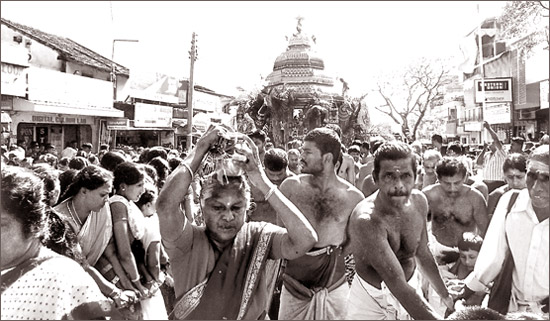 |
|
In the annual 10 days festival of
Vavuniya Town Kandasamy Temple, the ninth day chariot
festival took place. Large number of devotees participated
in the chariot festival.
Picture by T Vivekarasa – Vavuniya Spl corr |
|



